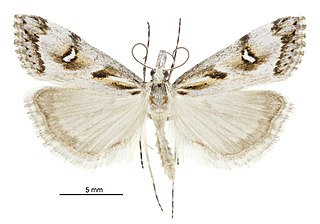
Epichorista aspistana is a species of moth of the family Tortricidae. It is endemic to New Zealand and has been collected in Canterbury and Otago. This species inhabits moist grassy areas at altitudes ranging from sea level to 1650m. Larvae feed on species within the genus Acaena. Adults are on the wing in November to February.

Gadira leucophthalma, commonly known as the beaked moss moth, is a moth in the family Crambidae. It is endemic to New Zealand. It is found in the south eastern side of the South Island down to Banks Peninsula. G. leucophthalma inhabits the foredunes of coastal areas. The larval host is unknown but it has been hypothesised that the larvae feed on moss. The adult moths are day flying although some specimens have been trapped at night via light traps. Adults are commonly on the wing from March to April. This species has been classified as Nationally Vulnerable by the Department of Conservation.
Anarsia acrotoma is a moth of the family Gelechiidae. It was described by Edward Meyrick in 1913. It is found in southern India.
Dichomeris ligyra is a species of moth in the family Gelechiidae. It was described by Edward Meyrick in 1913. It is found in Gauteng, South Africa.
Dichomeris cymotrocha is a species of moth in the family Gelechiidae. It was described by Edward Meyrick in 1913. It is found in South Africa.
Dichomeris doxarcha is a moth in the family Gelechiidae. It was described by Edward Meyrick in 1916. It is found in Myanmar.
Hypatima caryodora is a moth in the family Gelechiidae. It was described by Edward Meyrick in 1913. It is found in Assam, India.
Hypatima corynetis is a species of moth in the family Gelechiidae. It was described by Edward Meyrick in 1913. It is found in Sri Lanka.
Hypatima dissidens is a species of moth in the family Gelechiidae. It was described by Edward Meyrick in 1913. It is found in Mpumalanga, South Africa.
Hypatima silvestris is a moth in the family Gelechiidae. It was described by Edward Meyrick in 1913. It is found in Assam in India and Jiangsu in China.

Hypatima spathota is a moth in the family Gelechiidae. It was described by Edward Meyrick in 1913. It is found in Japan, Taiwan, India, Sri Lanka, China, Vietnam and Australia, where it has been recorded from Queensland.
Hypatima verticosa is a moth in the family Gelechiidae. It was described by Edward Meyrick in 1913. It is found in southern India.
Palintropa hippica is a moth in the family Gelechiidae. It was described by Edward Meyrick in 1913. It is found in Sri Lanka.
Stomopteryx oncodes is a moth of the family Gelechiidae. It was described by Edward Meyrick in 1913. It is found in South Africa.
Stomopteryx prolapsa is a moth of the family Gelechiidae. It was described by Edward Meyrick in 1918. It is found in Sri Lanka.
Stomopteryx biangulata is a moth of the family Gelechiidae. It was described by Edward Meyrick in 1921. It is found in Mozambique.
Polyhymno oxystola is a moth of the family Gelechiidae. It was described by Edward Meyrick in 1913. It is found in Mpumalanga, South Africa.
Thiotricha synodonta is a moth of the family Gelechiidae. It was described by Edward Meyrick in 1936. It is found in Korea and Japan.
Antaeotricha xylurga is a moth in the family Depressariidae. It was described by Edward Meyrick in 1913. It is found in Peru.

Trachypepla spartodeta is a moth of the family Oecophoridae first described by Edward Meyrick in 1883. It is endemic to New Zealand and has been collected in both the North and South Islands. This species inhabits native forest and adults are on the wing from November to January.



